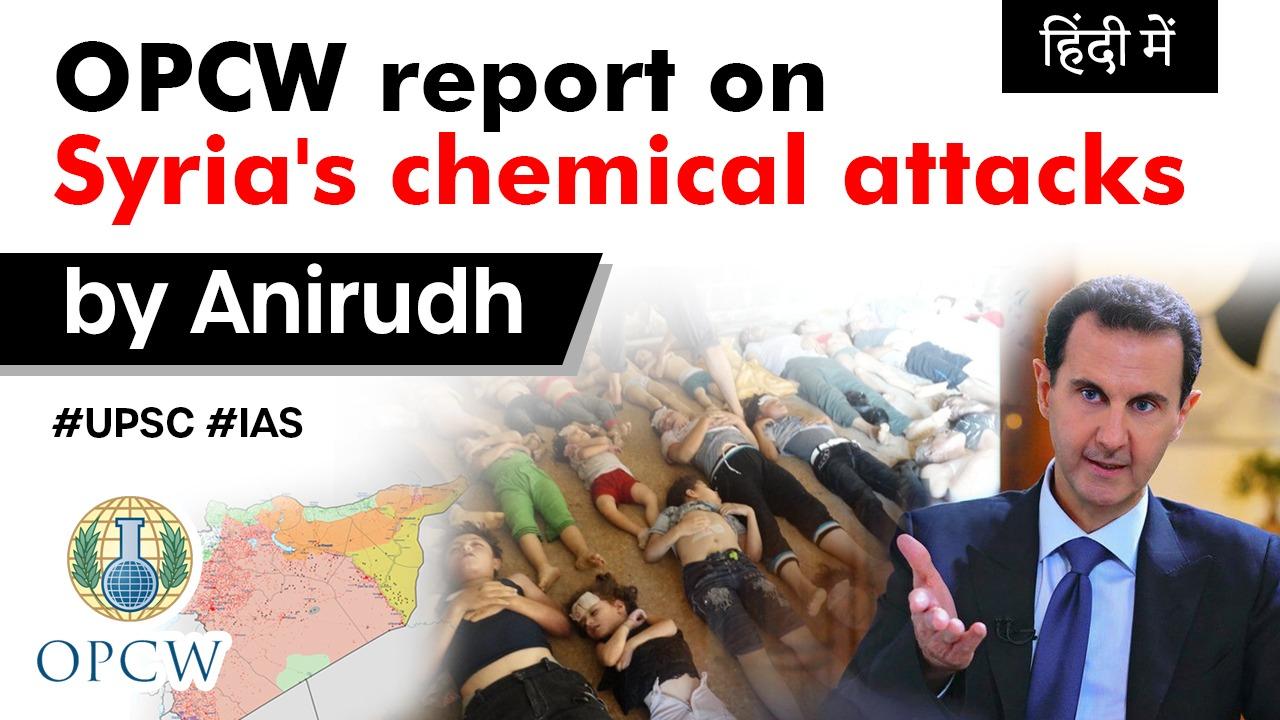Table of Contents

Chemical Weapon
- A Chemical Weapon is a chemical used to cause intentional death or harm through its toxic properties. Munitions, devices and other equipment specifically designed to weaponise toxic chemicals also fall under the definition of chemical weapons.

- The Organisation for the Prohibition of Chemical Weapons (OPCW) is an intergovernmental organisation and the implementing body for the Chemical Weapons Convention, which entered into force on 29 April 1997.
- HQ: Hague, Netherlands
- Awarded the 2013 Nobel Peace Prize “for its extensive efforts to eliminate chemical weapons”.
- Ultimate aim: to achieve a world permanently free of chemical weapons and to contribute to international security and stability
Background
- More than 34 chemical attacks happened in Syria after 2013
- On 25th March an attack was done on Al-Lataminah, Hama was carried out by helicopter killing at least 3 people and 32 injured

- Similarly on march 30th, a warplane dropped an aerial bomb injured about 169 people

Fact Finding Mission
- The mandate “to establish facts surrounding allegations of the use of toxic chemicals, reportedly chlorine, for hostile purposes in the Syrian Arab Republic”.
- The FFM’s mandate is to determine whether chemical weapons or toxic chemicals as weapons have been used in Syria. It does not include identifying who is responsible for alleged attacks
- To identify the perpetrator, OPCW established the Investigation and Identification Team (IIT) on 27 June 2018


- Investigation and Identification Team Under this mandate, IIT released its first report
Finding-1
- At approximately 6:00 on 24 March 2017, an Su-22 military airplane belonging to the 50th Brigade of the 22nd Air Division of the Syrian Arab Air Force, departing from Shayrat airbase, dropped an M4000 aerial bomb containing sarin in southern Ltamenah, affecting at least 16 persons.
- Sarin is a human-made chemical warfare agent classified as a nerve agent.
- Like other nerve agents, sarin targets an enzyme within the body’s neuromuscular junctions, where nerves meet muscles.
Finding-2
- At approximately 15:00 on 25 March 2017, a helicopter of the Syrian Arab Air Force, departing from Hama airbase, dropped a cylinder on the Ltamenah hospital;
- The cylinder broke into the hospital through its roof, ruptured, and released chlorine, affecting at least 30 persons.
Finding 3
- At approximately 6:00 on 30 March 2017, an Su-22 military airplane belonging to the 50th Brigade of the 22nd Air Division of the Syrian Arab Air Force, departing from Shayrat airbase, dropped an M4000 aerial bomb containing sarin in southern Ltamenah, affecting at least 60 persons.
Conclusion of the Report
- “The IIT has concluded that there are reasonable grounds to believe that the perpetrators of the use of sarin as a chemical weapon in Ltamenah on 24 and 30 March 2017, and the use of chlorine as a chemical weapon on 25 March 2017 were individuals belonging to the Syrian Arab Air Force.”
- Report Finds Syrian Government forces responsible for 2017 Chemical Attack
The IIT Coordinator
- Mr Santiago OñateLaborde stated
- Attacks of such a strategic nature would have only taken place on the basis of orders from the higher authorities of the Syrian Arab Republic military command.
What Next
- OPCW Director-General, H.E. Mr Fernando Arias, underscored that:
- The IIT is not a judicial or quasi-judicial body with the authority to assign individual criminal responsibility, nor does the IIT have the authority to make final findings on non-compliance with the Convention.
What Next
- It is now up to the Executive Council and the Conference of the States Parties to the Chemical Weapons Convention, the United Nations Secretary-General, and the international community as a whole to take any further action they deem appropriate and necessary.”
Latest Burning Issues | Free PDF






















 WhatsApp
WhatsApp